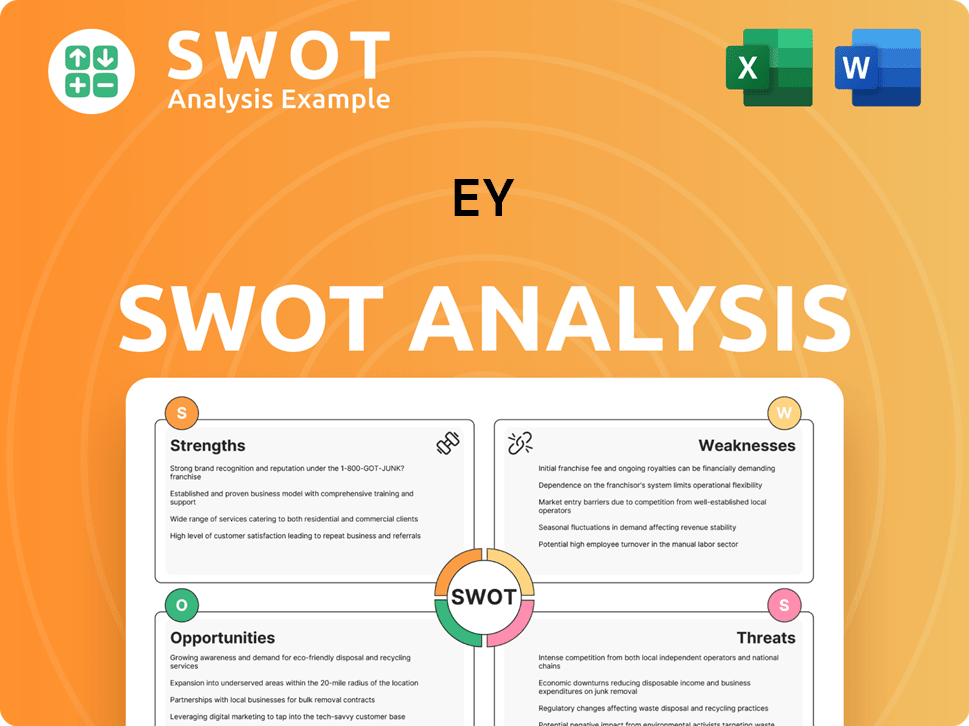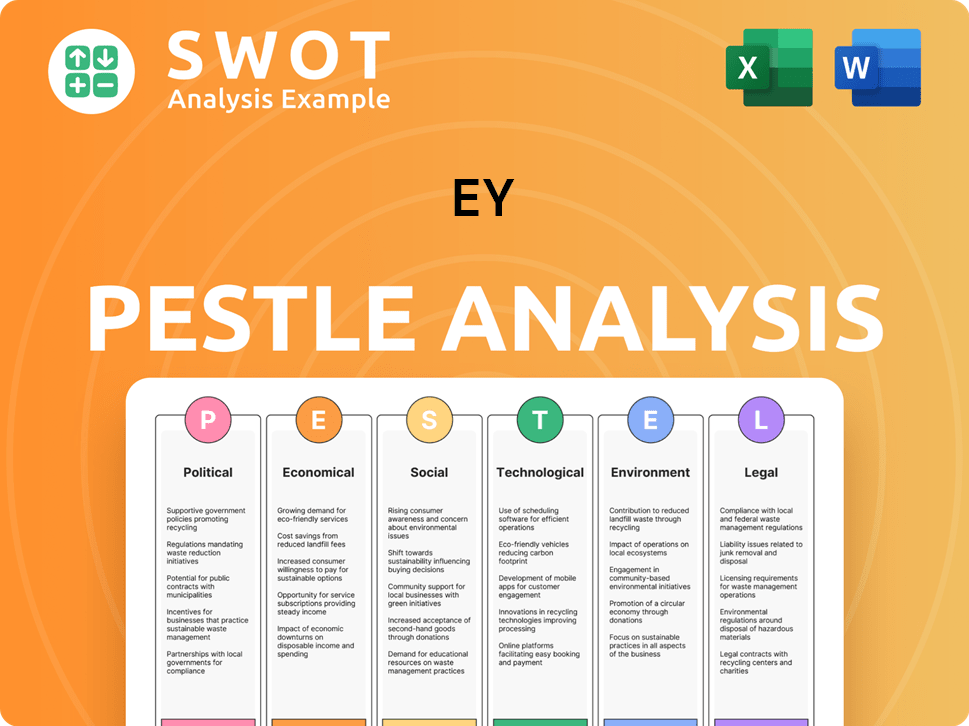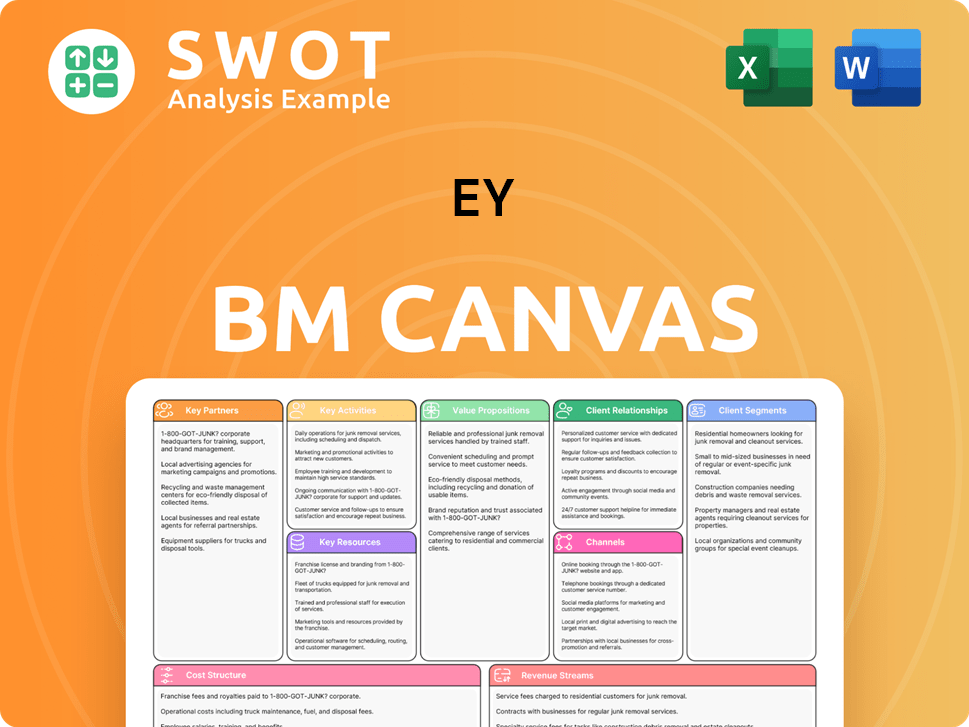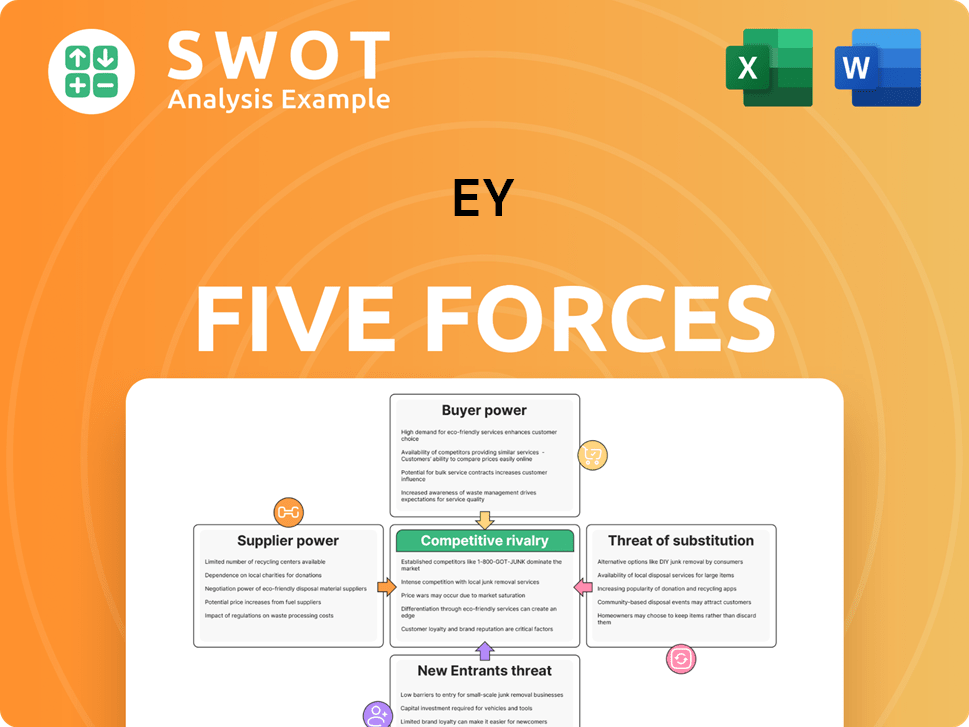EY Bundle
How well do you know the history of EY?
From its humble beginnings to its current global stature, the story of EY is a fascinating journey of adaptation and growth. Founded in the mid-19th century, this multinational professional services partnership has consistently evolved to meet the changing needs of the business world. Explore the EY SWOT Analysis to understand its current position.

Delving into the EY history reveals a narrative of strategic mergers, rebranding efforts, and unwavering commitment to client service. Understanding the EY company profile means exploring its origins and the key milestones that shaped it into one of the Big Four accounting firms. This exploration will uncover how Ernst & Young navigated challenges and capitalized on opportunities to become a global leader in assurance, tax, consulting, and strategy services.
What is the EY Founding Story?
The story of EY, a leading global professional services firm, is rooted in the late 19th and early 20th centuries. This EY company profile showcases a rich history of mergers and strategic growth. The firm's evolution reflects significant changes in the accounting and consulting industries.
The current structure of EY, as we know it, was established in 1989. This was a result of the merger between Ernst & Whinney and Arthur Young & Co. However, the origins of EY stretch back much further. The oldest predecessor firm, Harding & Pullein, was founded in England in 1849.
This chapter explores the founding story of EY, from its early beginnings to its emergence as a global leader in professional services. It highlights the key individuals, strategic decisions, and historical events that shaped the firm.
The EY history began with two key figures: Alwin C. Ernst and Arthur Young. Their visions and approaches laid the groundwork for the firm's future success.
- In 1903, Alwin C. Ernst and Theodore Ernst founded Ernst & Ernst in Cleveland, Ohio.
- Arthur Young, along with his brother Stanley, established Arthur Young & Company in Chicago in 1906.
- Ernst emphasized quality services and using accounting data to improve clients' businesses.
- Young focused on professional development and was an early recruiter from universities.
Both Ernst & Ernst and Arthur Young & Co. initially provided auditing and accounting services. They expanded internationally through strategic partnerships.
- International expansion began in 1923.
- Ernst & Ernst partnered with Whinney, Smith & Whinney.
- Arthur Young & Co. allied with Broads Paterson & Co.
- These partnerships were crucial for establishing a global presence.
The merger of Ernst & Whinney and Arthur Young & Co. in 1989 was a pivotal moment. It created the global firm known today as Ernst & Young (EY).
- The merger combined the strengths of both firms.
- It created a powerhouse in professional services.
- The merger was driven by a shared commitment to quality and client value.
- This marked a significant milestone in the EY timeline.
EY SWOT Analysis
- Complete SWOT Breakdown
- Fully Customizable
- Editable in Excel & Word
- Professional Formatting
- Investor-Ready Format

What Drove the Early Growth of EY?
Following the foundational mergers, the company, now known as Ernst & Young (EY), experienced significant growth and expansion. This period involved diversifying service offerings beyond traditional auditing, driven by market demand for management consulting services. The firm strategically expanded, both domestically and internationally, adapting to evolving industry needs.
A key aspect of the EY history was its international expansion. Building on the early agreements of its predecessor firms, the company strategically established new offices across various countries. This global reach was supported by strategic acquisitions and investments in recruitment and training to maintain service quality. By 1950, Ernst & Ernst had grown to 65 partners and 52 offices, showcasing early growth.
In May 2000, Ernst & Young made a significant strategic move in response to regulatory concerns. It became the first of the 'Big Five' firms to separate its consulting services. This division was sold to Capgemini for $11 billion. This strategic divestiture allowed EY to refine its business model while maintaining its focus on core professional services.
The firm's ability to adapt to the evolving competitive landscape and client needs has been a consistent theme. EY company profile continuously invests in technology platforms and artificial intelligence (AI) to assist clients in transformation and tackling global challenges. This focus on innovation has helped maintain its position among Big Four accounting firms.
Throughout its early years, EY origins and subsequent development, the firm has demonstrated a commitment to growth and adaptation. This includes strategic decisions like the separation of consulting services and ongoing investments in technology. For more details on the firm's evolution, you can explore the detailed history of the company.
EY PESTLE Analysis
- Covers All 6 PESTLE Categories
- No Research Needed – Save Hours of Work
- Built by Experts, Trusted by Consultants
- Instant Download, Ready to Use
- 100% Editable, Fully Customizable

What are the key Milestones in EY history?
The EY history is marked by significant milestones, reflecting its growth and adaptation within the professional services industry. From its EY origins to its current global presence, the firm has consistently evolved to meet the changing needs of its clients and the market.
| Year | Milestone |
|---|---|
| 1989 | The merger of Ernst & Whinney and Arthur Young created Ernst & Young, forming one of the Big Four accounting firms. |
| 2000s | EY expanded its global footprint, increasing its service offerings in consulting, tax, and advisory services. |
| 2023 | EY launched EY.ai, a platform designed to help clients adopt AI responsibly, and EYQ, a conversational AI assistant. |
| 2024 | EY launched a new global strategy called 'All in' to shape the next US$50 billion in revenue. |
EY company profile has consistently embraced innovation, particularly in technology and AI. These innovations aim to enhance audit quality, improve productivity, and provide more comprehensive services to clients.
In September 2023, EY launched EY.ai, a unifying platform to help clients adopt AI. This platform is a key part of EY’s strategy to become an AI-powered business.
EY invested $1 billion in a leading-edge technology platform to enhance trust, transparency, and transformation. Over 25 new Assurance technology features incorporating integrated AI have been introduced.
EY developed EYQ, a conversational AI assistant, which has processed over 68 million prompts since its launch in September 2023. This tool supports internal and client-facing operations.
EY prioritizes learning and development, issuing over half a million 'EY Badges' since the program's launch. This includes advanced learning in sustainability, data visualization, and AI.
EY is committed to sustainability, aiming to reduce greenhouse gas (GHG) emissions by 40% against an FY19 baseline by 2025. Progress has been reported for four consecutive years.
EY launched a new global strategy called 'All in' on July 1, 2024, aiming to shape the next US$50 billion in revenue through purposeful growth and targeted investments.
Despite its successes, Ernst & Young has faced challenges, including market downturns and competitive pressures. These challenges have prompted strategic adjustments and restructuring efforts to maintain profitability and growth.
In FY2024, revenue increased by 3.9% in local currency to US$51.2 billion, a slowdown compared to the previous year's double-digit growth. The consulting service line saw a modest 0.1% increase.
The Australian business reported a 6% drop in revenues for FY2024, primarily due to softened demand for transactions and consulting services. This reflects broader market pressures.
In March 2025, EY announced a substantial partner redundancy initiative in the UK, eliminating approximately 30 partner positions, mainly within its consulting division, to safeguard profitability.
EY has undertaken strategic pivots and restructuring efforts, including launching the 'All in' strategy, to address challenges and maintain its market position. This involves targeted investments and a focus on audit quality.
Despite challenges, EY continues to prioritize audit quality. Maintaining high standards in auditing is a core focus, ensuring trust and reliability in its services.
These experiences have reinforced EY's strength in adaptability and its commitment to long-term value creation. The firm continues to evolve to meet client needs and market demands.
For a deeper understanding of the firm's core values, consider reading about the Mission, Vision & Core Values of EY.
EY Business Model Canvas
- Complete 9-Block Business Model Canvas
- Effortlessly Communicate Your Business Strategy
- Investor-Ready BMC Format
- 100% Editable and Customizable
- Clear and Structured Layout

What is the Timeline of Key Events for EY?
The history of EY, one of the Big Four accounting firms, is marked by significant mergers, acquisitions, and strategic shifts. This EY company profile illustrates its evolution from its EY origins to a global leader in professional services, offering insights into its EY history. From its early beginnings to its current position, EY has adapted to changing market dynamics and regulatory environments. This EY timeline highlights key moments in its journey.
| Year | Key Event |
|---|---|
| 1849 | Harding & Pullein, a predecessor firm, is founded in England. |
| 1903 | Ernst & Ernst is founded in Cleveland, Ohio, by Alwin C. Ernst and Theodore Ernst. |
| 1906 | Arthur Young & Company is established in Chicago by Arthur Young and his brother Stanley. |
| 1923 | Both Ernst & Ernst and Arthur Young & Co. begin international expansion through agreements with British firms. |
| 1979 | Ernst & Ernst merges with Whinney Smith & Whinney to form Ernst & Whinney. |
| 1989 | Ernst & Whinney merges with Arthur Young & Co. to form Ernst & Young. |
| 2000 | Ernst & Young sells its consulting services to Capgemini for $11 billion. |
| 2013 | The firm officially rebrands to 'EY.' |
| FY2024 | EY reports global revenue of US$51.2 billion and a global headcount of approximately 392,995. |
| September 2023 | EY launches EY.ai, a unifying platform for AI adoption. |
| November 2024 | EY acquires J Group Consulting. |
| January 2025 | EY predicts 'more, smaller, and smarter' biotech and pharma M&A deals in 2025. |
| February 2025 | EY's research indicates that 47% of businesses invested in Generative AI in 2025. |
| March 2025 | EY announces plans to eliminate approximately 30 partner positions in the UK. |
| April 2025 | EY announces a global restructure merging 18 regional structures into ten super regions. |
EY is targeting purposeful growth, with investments in transformation, managed services, and sustainability. The firm aims to generate the next US$50 billion in revenue. This strategic direction is part of its 'All in' global strategy launched in July 2024.
EY continues to invest heavily in technology, data, and AI. EY US plans to invest $1 billion over three years in talent and technology. This includes boosting compensation and increasing AI-enabled audit and tax platforms.
EY is committed to sustainability, with a refreshed Global Environment Strategy for FY25 to FY30. The firm aims to halve emissions by FY30 and achieve net zero by FY50. This commitment underscores its dedication to environmental responsibility.
EY anticipates increased M&A activity in 2025, particularly in private equity and corporate sectors. The firm expects rises of 16% and 8%, respectively. For more details on EY's business model, explore Revenue Streams & Business Model of EY.
EY Porter's Five Forces Analysis
- Covers All 5 Competitive Forces in Detail
- Structured for Consultants, Students, and Founders
- 100% Editable in Microsoft Word & Excel
- Instant Digital Download – Use Immediately
- Compatible with Mac & PC – Fully Unlocked

Related Blogs
Disclaimer
All information, articles, and product details provided on this website are for general informational and educational purposes only. We do not claim any ownership over, nor do we intend to infringe upon, any trademarks, copyrights, logos, brand names, or other intellectual property mentioned or depicted on this site. Such intellectual property remains the property of its respective owners, and any references here are made solely for identification or informational purposes, without implying any affiliation, endorsement, or partnership.
We make no representations or warranties, express or implied, regarding the accuracy, completeness, or suitability of any content or products presented. Nothing on this website should be construed as legal, tax, investment, financial, medical, or other professional advice. In addition, no part of this site—including articles or product references—constitutes a solicitation, recommendation, endorsement, advertisement, or offer to buy or sell any securities, franchises, or other financial instruments, particularly in jurisdictions where such activity would be unlawful.
All content is of a general nature and may not address the specific circumstances of any individual or entity. It is not a substitute for professional advice or services. Any actions you take based on the information provided here are strictly at your own risk. You accept full responsibility for any decisions or outcomes arising from your use of this website and agree to release us from any liability in connection with your use of, or reliance upon, the content or products found herein.